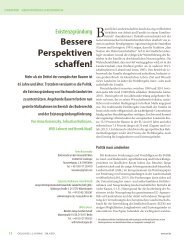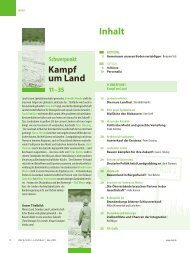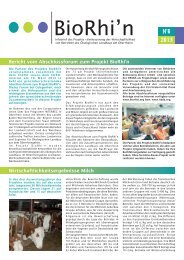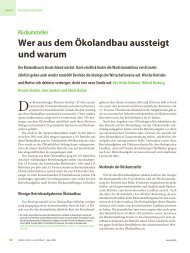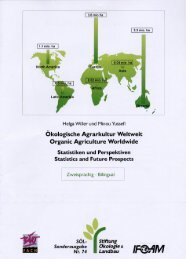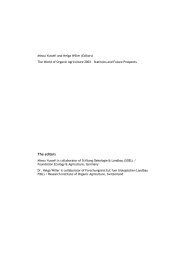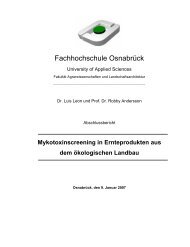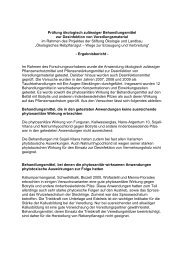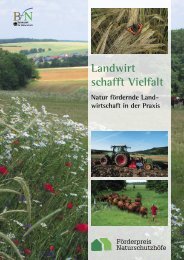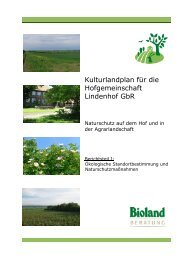the world of organic agriculture - Organic Eprints
the world of organic agriculture - Organic Eprints
the world of organic agriculture - Organic Eprints
You also want an ePaper? Increase the reach of your titles
YUMPU automatically turns print PDFs into web optimized ePapers that Google loves.
140<br />
The World <strong>of</strong> <strong>Organic</strong> Agriculture 2006<br />
companies grew more steadily. ‘NaturaSi’, <strong>the</strong> largest Italian <strong>organic</strong> supermarket chain, with 42<br />
outlets, reports 13 percent growth in 2004 and in <strong>the</strong> first half <strong>of</strong> 2005.<br />
<strong>Organic</strong> food is supplied through a number <strong>of</strong> different channels, including public procurement,<br />
specialist shops, traditional supermarkets, restaurants and farm holidays. More school canteens<br />
are <strong>of</strong>fering <strong>organic</strong> meals because <strong>of</strong> promotional campaigns and new local regulations. The region<br />
<strong>of</strong> Emilia-Romagna passed a new law, supported by <strong>the</strong> Green regional deputy, which approved<br />
<strong>the</strong> development <strong>of</strong> <strong>organic</strong> canteens for local schools. Most <strong>of</strong> <strong>the</strong> wholefood and <strong>organic</strong> food<br />
shops are concentrated in Nor<strong>the</strong>rn Italy, among <strong>the</strong>m approximately 100 <strong>organic</strong> supermarkets<br />
<strong>of</strong> over 200m2 retail area. Many supermarket chains in Italy are marketing <strong>the</strong>ir own label <strong>organic</strong><br />
products. One chain, Serramarina, has opened a new concept store in Padua, featuring 25 percent<br />
<strong>organic</strong> products compared with <strong>the</strong>ir usual 8 to 9 percent. They are hoping to expand this idea by<br />
opening such stores around o<strong>the</strong>r regions <strong>of</strong> Italy and throughout Europe.<br />
The market for <strong>organic</strong> products in Denmark continues to grow slowly in <strong>the</strong> most important<br />
sales channel <strong>of</strong> multiple retailers. Statistics for o<strong>the</strong>r supply channels are patchy, but it seems<br />
that overall <strong>organic</strong> sales are being sustained without substantial decreases. The recent political<br />
emphasis on promoting <strong>organic</strong> farming through <strong>the</strong> market, along with recent slower growth in<br />
<strong>the</strong> retail market, has led to continued reductions in <strong>the</strong> Danish <strong>organic</strong> land area and numbers<br />
<strong>of</strong> producers. This “standstill” phase in <strong>the</strong> development <strong>of</strong> Danish <strong>organic</strong> farming follows a<br />
sustained period <strong>of</strong> growth throughout more than a decade, and <strong>the</strong> <strong>organic</strong> sector continues to<br />
be an important influence in Danish farming 25 .<br />
In Austria, <strong>the</strong> <strong>organic</strong> sector has been streng<strong>the</strong>ned by <strong>the</strong> foundation, in January 2005, <strong>of</strong><br />
a single membership organization for <strong>organic</strong> farmers, called Bio Austria. The idea was first<br />
discussed in 1993, followed by intensive consultations between <strong>the</strong> 19 former <strong>organic</strong> farmers’<br />
associations. Now representing over 14’000 <strong>organic</strong> farmers, Bio Austria aims not only to become<br />
<strong>the</strong> main communication and information network for <strong>the</strong> whole Austrian <strong>organic</strong> sector but also<br />
to help increase <strong>the</strong> number <strong>of</strong> farms and <strong>organic</strong> land area by ten percent each year 26 . Despite this<br />
positive development in <strong>the</strong> production sector, <strong>the</strong> Austrian retail market showed slow growth<br />
in <strong>the</strong> last year, remaining at between twelve percent <strong>of</strong> sales for milk and potatoes, and two<br />
percent for sausages. A national Bio Austria advertising campaign, promoting <strong>the</strong> fact that <strong>organic</strong><br />
products are free <strong>of</strong> GMOs, was taken <strong>of</strong>f <strong>the</strong> air by <strong>the</strong> Austrian Agricultural Market Agency<br />
(AMA) because <strong>of</strong> intensive protests from <strong>the</strong> conventional food and farming lobby, but <strong>organic</strong><br />
farmers are now trying to reverse that decision. Austria is also <strong>the</strong> home <strong>of</strong> Bio-Hotels, a recently<br />
formed association <strong>of</strong> independent hotels <strong>of</strong>fering holidays based around natural products<br />
with <strong>organic</strong> and local food. Apart from Austria, <strong>the</strong> association also has members in Germany,<br />
Switzerland, Italy, Ireland and Spain 27 .<br />
In <strong>the</strong> Ne<strong>the</strong>rlands, <strong>the</strong> retail market has developed confidently with growth rates <strong>of</strong><br />
approximately five percent. This may be a result <strong>of</strong> <strong>the</strong> government focus on improving marketing<br />
25 http://www.lr.dk/oekologi/diverse/org_agri.htm<br />
26 www.bio-austria.at<br />
27 http://www.biohotels.info



